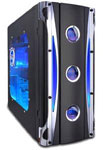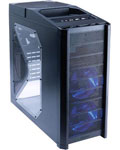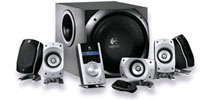Displays, Cases and Peripherals
| Base High-End Case and Accessories |
| Hardware |
Component |
Price |
Rebates |
| Display |
Acer AL2216Wbd 22" 5ms 1680x1050 |
$250 |
- |
| Case |
Apevia Aspire X-Cruiser |
$59 |
- |
| Power Supply |
Corsair CMPSU-620HX |
$126 |
- |
| Keyboard and Mouse |
Microsoft Comfort Curve 2000 with Optical Mouse |
$28 |
- |
| Speakers |
Creative I-Trigue 3300 |
$73 |
- |
| Total |
$536 |
$536 |
The monitor chosen as a minimum for the high-range systems is the
Acer AL2216Wbd. The 22" display has a 5ms response time and a resolution of 1680x1050, and while our review found that it wasn't competitive in terms of overall quality with most of the 24" LCDs, it's hard to argue with the significantly lower price. Regular readers of the Guide section of AnandTech will recognize this monitor as a frequent selection during the past few guides, and also notice that the price has dropped significantly on this model.
 |
Apevia is generally known as a component-brander, rather than a manufacturer, whose products typically target the value segment. The Aspire X-Cruiser case is, accordingly, a steel case, but it has lots of interesting embellishments. The clear side window, fan speed controller, fan speed indicator, and blue LEDs provide a lot of value compared to more well-known cases. Airflow is handled by two 80mm fans. Depending on your personal tastes, you may or may not like this case, but there are plenty of people that simply view the case as something to hold the rest of the components and for such users the Aspire X-Cruiser is a nice fit. Note that this case is an entry-level recommendation - if you are targeting this segment, you have more than ample choices to ensure that you get one that fits your needs.
The Corsair CMPSU-620HX is a solid offering from a company long known for providing excellent power supplies. Claiming an 80% efficiency rating and sporting three 12V rails rated at 18A, this power supply handles all hardware recommended in this Guide without issue at stock speeds. Overclockers (especially on quad core systems) and water-coolers, however, should look to the larger PSU offerings to ensure system stability. Airflow is provided by a bottom-mount 120mm fan. The Corsair power supplies are rebranded SeaSonic units, so if you prefer a SeaSonic S12 (or can find it for less money) the two are essentially the same.
 |
For the entry level speaker selection, we turn to Creative Labs. Creative's products run the gamut from entry-level to enthusiast, with a focus on PC gaming. The C44-6004, while not quite the pinnacle of Creative's effort, provides gamers with a solid audio environment, especially at the given price point. The Creative features entry-level 7.1 sound. Logitech's X-530 and X-540 are as usual viable alternatives in this price bracket. Any speakers selling for under $100 are definitely more midrange rather than high-end, but for a lot of people that's more than enough.
| Mainstream High-End Case and Accessories |
| Hardware |
Component |
Price |
Rebates |
| Display |
Dell UltraSharp 2407WFP |
$569 |
- |
| Case |
Antec Nine Hundred |
$115 |
- |
| Power Supply |
PC Power Silencer 750 Quad |
$200 |
- |
| Keyboard and Mouse |
Microsoft Natural Keyboard and 5000 Optical Mouse |
$61 |
- |
| Speakers |
Logitech Z-5300e |
$145 |
- |
| Total |
$1090 |
$1090 |
Most users either love or hate the Antec Nine Hundred case. The appearance of this steel mid-tower offering is something that has yet to be imitated by a competitor (draw what conclusions you will), but it's impossible to argue against this being a hardcore case. Four fans, including a 200mm behemoth at the top, ensure that airflow is more than adequate for even the most demanding of components. USB, FireWire, and audio ports for the case sit at the top, which makes a lot of sense, given that cases are usually on the floor.
An upgraded high-end solution deserves a larger display, and the Dell UltraSharp 2407WFP fills the need. Staying true to its name, Dell offers this 1920x1200 panel with virtually the same specifications as competing designs from Samsung (
244T) and others, but at a significantly lower price point. The 3 year warranty seals the deal.
The power supply also gets an upgrade for this package, making a fairly large jump up to the PC Power Silencer 750 Quad. This power supply is built to perform, with the capability of delivering a full 60A on its single 12V rail. At $195, it is a premium level component to be sure - but at this level, the additional cash outlay eliminates any concerns of power instability in our high-end system. The inclusion of four PCI-E 6-pin power adapters will definitely work well with the SLI 8800 GTX configurations.
Finally, the sound system makes the jump into the land of THX, with the Logitech Z-5300e package. The silver accents on the speakers are themselves another example of styling which provokes either a love-or-hate reaction; however, the sound quality from the system (particularly the subwoofer) places the audio aspect of these components squarely into the "enthusiast" category.
| Ultra High-End Case and Accessories |
| Hardware |
Component |
Price |
Rebates |
| Display |
Samsung 305T 30" 2560x1600 |
$1331 |
- |
| Case |
Kandalf VD4000BWS Liquid Cooled |
$270 |
- |
| Power Supply |
OCZ POWER GAMER OCZ1010GXSSLI |
$251 |
- |
| Keyboard and Mouse |
Logitech G15 Gaming Keyboard and G5 Mouse |
$110 |
- |
| Speakers |
Logitech Z-5500 |
$233 |
- |
| Total |
$2195 |
$2195 |
Yes, the
Dell 30" 3007WFP usually can be found for a little bit less than the Samsung 305T in the Ultra High-End selection; however, the newer 3007WFP-HC costs a bit more. The Samsung 305T panel therefore gets the nod for the display device on our $5000 rig, as you also get two dual-link DVI inputs whereas the Dell LCDs only include one. Like all current 30" panels, this display features a native 2560x1600 resolution; every ounce of horsepower in our 8800 GTS/GTX SLI configurations will be put to the test. For those interested in the improved color gamut of the newer Dell LCD, we would also suggest taking a look at the
HP LP3065, which offers the same improved color gamut but also includes three dual-link DVI ports.
At the extreme end of the spectrum, a case with built-in liquid cooling makes a lot of sense, and the Thermaltake Kandalf is an excellent way to go. The VD4000BWS is a truly amazing case, with three 120mm fans and blue LEDs complementing the aforementioned liquid cooling. This case is a monster, with nine 5.25" bays and eight 3.5" bays (two external) housing whatever components a user could dream of throwing in. Considering many water-cooling solutions can cost several hundred dollars, the overall price of this case plus water-cooling kit is very attractive. If you would prefer to avoid water cooling altogether, the Cooler Master 830CM Stacker case is a strong alternative.
The power supply for the system gets another nudge to the OCZ Power Gamer 1010GXSSLI. Going a couple notches further than the PC Power unit, the 1010GXSLI sports four 20A 12V rails, which is enough to handle even the water-cooled SLI setup chosen for the most expensive systems in this Guide.
For those of us with $5000 (okay, $5328) to spend, the Logitech Z-5500 Digital system is the only way to go. A powerful subwoofer placed only a few feet from a gamer can't be anything but good, and you'll be hard pressed to resist playing with that LCD control panel. The total sound volume is impressive given the price, and only much more expensive (and larger) home theater equipment will really put these speakers to shame. You don't necessarily need speakers this loud... but you know you want it.
















69 Comments
View All Comments
Dantzig - Tuesday, May 29, 2007 - link
All in all, I liked your guide. Welcome aboard to Anandtech :)Even for a "base" high-end configuration, your case and peripheral recommendations are simply not acceptable.
The Apevia Aspire X-Cruiser is a riced-out, poorly ventilated, cheaply made and simply obnoxious case. Why not recommend a much more sensible option with better ventilation and construction? You can get many quality cases sans power supply for $60. The Antec recommended in the mainstream configuration is much better suited to a high-end build (although I would still like to see something more sensible and less noisy).
Similarly, the Creative Labs 7.1 speaker system you recommended (actually the Inspire P7800, not I-Trigue 3300) is just junk. There is absolutely no reason to waste $80 on a crap 7.1 speaker system. A system with that many speakers should be done right or not at all. Also, THX and manufacturer's power ratings are just marketing mean nothing to anyone who knows jack about audio. Just recommend a decent 2.1 system that at least has tweeters. The market for real stereo systems with actual receivers starts around $250 these days. Even a low end HTIB (I like Onkyo) will outperform any computer speakers on the market.
takumsawsherman - Tuesday, May 29, 2007 - link
So here are a couple of additional comments."The Corsair CMPSU-620HX is a solid offering from a company long known for providing excellent power supplies" - I wasn't aware that Corsair had power supplies at all before a couple of years ago. Also, Why the PC Power and Cooling product over something like a high end Seasonic?
Now, for the worst part... Thanks to the assistance of the Anandtech forums, I finally found a case that I could put into a business environment that wasn't filled with useless lights, very tasteless appointments on the exterior, or cartoon characters on the side. Antec's cases have been de-improving in terms of accessibility (witness the Sonata II and it's funky air flow system that is a pain in the rear and doesn't seem to improve temps). So I was referred to the I-Star S-8 Storm series. An excellent case, with excellent accessories (Hot swap bays, removable caddys, redundant power supplies) that retails for around $50-$60. No spiderman face, no crazy lights, and the fastest assembly I have ever done. There is one downside, in that they don't like to give you enough screws of any one type, and hopefully they will improve that. Luckily, I have tons of screws left over from other systems built for customers over the years.
I believe that part of the problem stems from reviewers praising really toy-like cases that have all of these useless features. Yes, the 14 year old gamer might think they're cool. Heck, even some 25 year old gamers may think they're cool. But I think the great majority of people would consider them to be tacky. So, how about a compromise: offer up alternatives for each. One with all the glitter, and the other with a more clean look. We should encourage manufacturers to worry more about ease of assembly and functionality, and something that can be sold to a business customer.
anandtech02148 - Tuesday, May 29, 2007 - link
hahah this is so true most pc case are so tacky, this is why Apple can steal your money with it's well thought out designs.I still wonder why these plastics take so much space in retail stores.
The attraction is a well thought out pc case with high prices that you can at least get away with like a Lian Li.
Producing cheap plastic case to cut some cost is not a bad idea, but at least hire some designers.
Martimus - Tuesday, May 29, 2007 - link
Most people have considered PC Power and Cooling the best PSU maker for years. They have just been so expensive, not many people usually buy them. They are kind of like the BMW of power supplies, because they don't cut any corners in the design, but you pay for that in the bottom line price. Since the other companies are now charging similar prices to PC P&C, it is much easier to consider them now. Ofcourse PC Power and Cooling was just purchased by OCZ this month (MAY 2007), so hopefully their quality won't go down to the level of OCZ power supplies.Sunrise089 - Tuesday, May 29, 2007 - link
It's always nice to see Anandtech updating it's price guides, and if the new editor/writer follows Jarred's example then I'm sure he will do fine.A few things to maybe keep in mind: I echo the feelings of some others that a $5000 machine needs to have a soundcard. In fact, I would think it makes MUCH more sense to recommend a soundcard rather than a set of speakers for such a system. Next, why keep mentioning overclocking in the article and never advice a aftermarket HSF? I would think every PC in the $2000+ range would be well served, even if only to run it in a low-noise configuration and keep low temps. I assume a midrange guide will appear next, probably after P35 arrives. I hope to see another Overclocking subconfiguration in that atricle, since many of us to OC and the component choices can be rather different.
Finally, @ Jarred - nice fancy new title and post sig. Hopefully thought you won't be only working on notebooks and displays in the future however, even if you are passing on the Guide articles. I know many of the more unconventional articles you and Gary write are some of the best stuff to appear on the site, and I'd hate to loose you to only reviewing the new Asus notebook or Dell LCD.
Dave Robinet - Thursday, May 31, 2007 - link
Thanks for the welcome. :)You're absolutely right, both about the soundcard and the HSF. In the $5k system, though, we did include the water cooling solution - but point taken about the cooling in general terms. I'd venture that few people at the $2k range are using stock HSF solutions.
For the next guide, I'm thinking that there may be some tweaks - you're right about the overclocking part.
Thanks again!
dave
JarredWalton - Tuesday, May 29, 2007 - link
Thanks,I'm still managing editor (i.e. posting most other articles, doing final proof-reads, etc.) so no worries. Displays and laptops are simply my primary area of focus these days, just like Derek's focus is GPUs and Gary's primary focus is... well, everything. :) I'll still contribute opinions and such to the Buyers' Guides as well (and Gary deserves plenty of credit for the recommendations in this and other Guides if you didn't know that).
takumsawsherman - Tuesday, May 29, 2007 - link
Page 3 states that "While RAID will not markedly improve performance for the average user, it can improve either reliability (RAID 5, RAID 1), or data capacity (RAID 0)"I don't see how RAID 0 improves data capacity. Sure, it will make multiple drives appear as one volume, but the capacity is not improved. Not only that, but the reliability is decreased, as a failure of one drive leads to loss of data from both.
JarredWalton - Tuesday, May 29, 2007 - link
That's what was meant by improving "data capacity" although it probably could have been worded better. It does improve performance in certain applications to the point that a few people might find it useful (people that worry about the latest ORB results for example....)Latyshev - Tuesday, May 29, 2007 - link
In the main review you are clearly goiung for SLI. But in the "alternative" list you never mention any new P35 boards, which are amasing peformers.
How come?